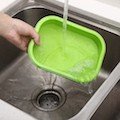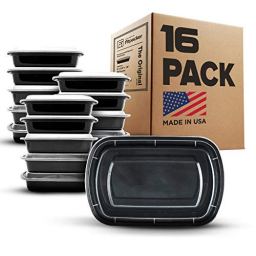Buying guide for Best meal prep containers
Many of us strive to eat a healthy diet, but all too often good nutrition takes a back seat to busy schedules and growling hunger pangs. Devoting a portion of your weekend to planning and prepping meals for the week ahead is a great way to save time and keep up with nutritional goals.
When it's time to store your food, relying on a motley collection of mismatched takeout containers can be a recipe for disaster. A good set of meal prep containers will reward your culinary efforts by keeping food fresher longer and keeping you organized.
Types of meal prep containers
Most meal prep containers are made of plastic or glass, but you're likely to come across a handful made of stainless steel or silicone, too. Different materials have different strengths and weaknesses. To help you find a good match, we’ve outlined the advantages and drawbacks of each.
Plastic
Easy on the pocket and highly portable, plastic meal prep containers are a popular choice for many.
Pros:
Cons:
-
Retain odors and stains
-
Not all are non-toxic, BPA-free
-
Scratches, scrapes can harbor bacteria
-
Heating damaged containers can leach chemicals
Price: Plastic meal prep containers are hands down the most affordable with sets of 15 or more containers costing anywhere between $10 and $30, depending on size, quality, and features like compartments and appliance compatibility.
Glass
Glass meal prep containers generally cost a little more, but if you're concerned about the safety of plastic or simply want a more versatile option, these are a great alternative.
Pros:
Cons:
Price: On average, a set of nine glass meal prep containers of varying shapes and sizes costs between $25 and $50, depending on individual container sizes and overall quality.
Stainless steel
While meal prep containers made of stainless steel aren't as popular as plastic or glass, they do have some unique advantages.
Pros:
Cons:
Price: If you find the appearance or durability of stainless steel appealing, hold onto your hat – a set of three meal prep containers typically costs between $20 and $40.
Silicone
Relatively new, silicone meal prep containers have a unique collapsible design that allows for easy storage. While this space-saving feature works well for home use, we don't recommend using these for meals on the go.
Pros:
-
Don't require much storage space
-
Don't crack, shatter, or chip
-
Freezer safe
-
Microwave safe
-
Oven safe
-
Don't leach chemicals in high temperatures
Cons:
Price: If you're short on space and think that collapsible silicone meal prep containers might be a good solution, you can expect to spend around $15 to $40 for a set of four.
Weekday dinners vs. healthy lunches
Efficient meal prep means different things to different people. Busy parents might simply want to cut down on time spent in the kitchen, while health-conscious individuals often have more specific nutritional aspirations. Either way, you need to choose the right set of containers for you.
Weekday dinners
Dreaming of drama-free family dinners? Several larger glass containers will keep chopped veggies, pre-boiled rice, or marinated meats fresh until you’re ready to cook, allowing you to whip up nutritious meals in record time.
Healthy lunches
If you’re more interested in meeting certain daily nutritional requirements or beating temptation, opt for multiple lightweight meal prep containers so you can easily take your lunch and a snack wherever you go.
Caution
Repeated exposure to high temperatures can damage seals and degrade plastic. Hand-washing helps your meal prep containers last longer.
STAFF
BestReviews
Meal prep container features to consider
There's more to meal prep containers than just lids, holders, and whatever you decide to put between them. Depending on your needs, the following features are worth noting.
Leak-proof lids
If you're prepping a week’s worth of grab-and-go lunches, tight-fitting lids are a must. There's nothing more disheartening than taking the time to prepare and pack a nourishing meal only to have it ooze out of its container and destroy the contents of your bag.
Compartments
Compartments make it possible to pack foods into a single container that you’d normally pack separately (like a sandwich and raw veggies). Although this isn’t a priority for everyone, keeping food groups separated also makes for a neater presentation and cleaner flavors.
Stackable storage
Nesting food prep containers require less storage space and are less likely to end up in a jumbled mess of missing pieces.
Microwave-, oven-, and/or freezer-safe materials
At the end of the day, meal prep is supposed to make healthy living just a little bit easier. Meal prep containers that are easy to heat and/or freeze offer the most versatility and convenience.
Easy to clean
Nobody wants to eat food that tastes (or smells) like last week's lunch. Suspicious aromas and aftertastes can ruin your meal, so keeping your containers and lids squeaky clean is essential. Many meal prep containers can go in the dishwasher. Nonporous materials like glass and stainless steel are easy to clean, but food particles and fluids can hide in crevices around the seals on plastic lids. Compartments can also make cleaning a bit trickier. If you’re washing by hand, be sure to give corners extra attention.
Container shapes and sizes
Uniformly shaped containers are easier to store and can reduce clutter in your fridge. However, having containers of varying shapes and sizes in your meal prep arsenal comes in handy, too. Tiny containers might seem useless until you find yourself poking at a naked salad and longing for a tablespoon of low-calorie dressing to liven it up. Whole fruits, low-carb muffins, and other grab-and-go snacks still need to be properly packaged but don't fit in shallow containers. While you might not use every size every day, having them can help keep things interesting.
Portability
Size, shape, lids, and weight all have an impact on the portability of your meal prep containers. Slim, flat containers are easy to slide into a bag alongside other everyday essentials. If you carry a small lunch or cooler bag, stacking two or three containers of different sizes can offer a little more mealtime freedom. For commuting, lighter plastic containers will enable you to carry extras without adding unnecessary weight.
Tips
-
Check that your containers don’t leak before using them. The easiest way to do this is to fill the container with water, snap on the lid, and turn it upside down (preferably over a sink).
-
Keep microwave heating to a minimum for plastic containers. Repeated exposure to high temperatures can damage plastic and limit the usable life of the containers.
-
Use clear containers and lids to easily identify contents.
-
Don’t use containers that are too large. Having a large volume of air trapped with your food can cause it to spoil more quickly.
- Consider adding Mason jars to your meal prep equipment. These are great for things like salads, burrito bowls, overnight oats, or chia pudding.
FAQ
Q. How long will food stay fresh in a meal prep container?
A. That depends on a number of factors, including what the food is, the temperature of your fridge, and whether your container is airtight. Most foods can be kept in the fridge for around three to five days, but many people draw the line at day four just to be on the safe side.
Q. How many meal prep containers do I need to get started?
A. To figure out how many containers you need, consider how many of your daily meals you'd like to prep. Are you just looking for a lunchtime solution or would you rather have an entire day’s worth of meals ready when you need them? We recommend having at least four containers for breakfast, four for lunch, four for dinner, and four smaller containers for nut butters or salad dressing. Having a few extras on hand for snacks doesn’t hurt either.
Q. When is the best time to prep and pack food?
A. Sundays work well for most people. Having all your meals prepped and packed for the upcoming week is a great motivator and leaves little room for slipups. However, there are some exceptions. Stay-at-home parents can't always devote Sundays to meal prep and might prefer to wait until Monday when the house is quieter. Choose a time that works best for you.




















